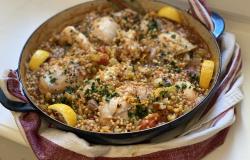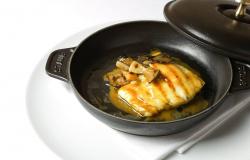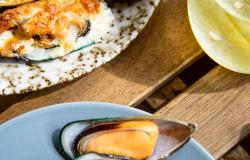Roasted Porcini Mushrooms

In Italy, the four most common porcino varieties grow under chestnut, beech, oak, and pine trees in not-too-densely forested areas, thriving on a vigorous combination of sunlight and rain. Although wild mushrooms have long been harvested commercially here, only recently has the porcino’s popularity exploded, cementing its reputation as the country’s most beloved fungo. In most of Southern Italy, for instance, porcini were not ‘discovered’ until around the mid-20th century (whereas in parts of Lazio, Tuscany, and other regions, they were traded in great quantities in the 19th century and earlier). And yet, although a relatively contemporary phenomenon, the fundamental association of the porcino mushroom with Italian cuisine is, in fact, the result of a long and complex history of local commercial activity, import and export patterns, fluctuating demand, and clever marketing.
Much has been brought to light in recent years on the question of authenticity of Italian porcini. A 2008 study by two Italian mycologists* demonstrated that the import of mushrooms into Italy between 2002 and 2005 vastly exceeded the amount of mushrooms exported from Italy, with troubling implications. Mushrooms from Romania, Bulgaria, and other parts of Eastern Europe and even as far away as China are commonly shipped to Italy, treated, and re-packaged with a touch of Italian flair before being exported to other parts of the world. Within Italy’s borders, the situation is much the same, particularly for dried mushrooms.
For a people virtually obsessed with the concept of authentic food, the topic of imported porcini mushrooms stirs no small amount of controversy among Italians (just try broaching the subject with them!). While imported porcini are not by definition of inferior quality, there are attendant issues to consider, such as contamination and freshness. Imported dried porcini purchased from a reputable source are not likely to present any problems, but if you are concerned about getting fresh, locally-harvested mushrooms, ask around at your farmers’ market. Gathering mushrooms for commercial use requires a special license, and vendors should be prepared to tell you about the origins of their product. You can do the same at the grocery store. Mycological societies are also great resources for both learning about mushrooms and connecting with experts.
Look for fresh porcini that are firm, full, with a cap that is medium to medium-dark brown in color. Inspect them for black spots, tiny holes (which can mean parasites), or a too-yellowish coloring of the cap’s spongy undersides (the whiter the sponge, the fresher the porcino). Once you’ve got your hands on some lovely fresh porcini, consider the various ways to use them: sliced and batter-fried, grilled, in soups or risotto, chopped and sautéed as a pasta sauce. The recipe here works well as a main course or a side dish.
Preheat the oven to 180° C /355° F.
The porcino is a very spongy mushroom that you really don’t want to wet. To clean them, start by cutting the bottom inch or so, usually quite dirty, off the stem. Using a fine brush, give the entire mushroom a thorough brushing to remove as much dry dirt as possible (mushroom gatherers sometimes do this in the forest to spread the spores around). Next, gently wipe them down with a damp, soft tea towel. Be careful not to wipe away the cap’s thin layer of skin. Let them recover a few minutes and brush them again if necessary.
Remove the caps from the stems with a gentle twist. If the cap resists, use a dull kitchen knife or teaspoon to gently pry the cap from the stem. The idea is to not break the cap, if possible. The stems can be set aside to be dried later (see below). Place the caps in a baking dish. Drizzle them with olive oil, dust with chopped fresh parsley and salt and pepper to taste. Toss a clove of garlic in the baking dish or grate the clove over the caps (optional). Bake for about 20 minutes. The mushrooms are done when they are slightly wrinkled, very soft, and have shrunk in size a little. Serve them with the pan juices.
To dry the stems: Slice them lengthwise into about ¼ inch strips. String them together using a needle and thread and hang in a dry place, preferably one that gets sunlight (something like an enclosed porch is ideal). Or, place the pieces on a gauze cloth and store in a dry, sun-lit place, turning them periodically. Once fully desiccated, store them in a glass jar in the pantry.
*Sitta, N. & Floriani, M (2008). Nationalization and Globalization Trends in the Wild Mushroom Commerce of Italy with Emphasis on Porcini (Boletus edulis and Allied Species). Economic Botany 62(3), 307.




